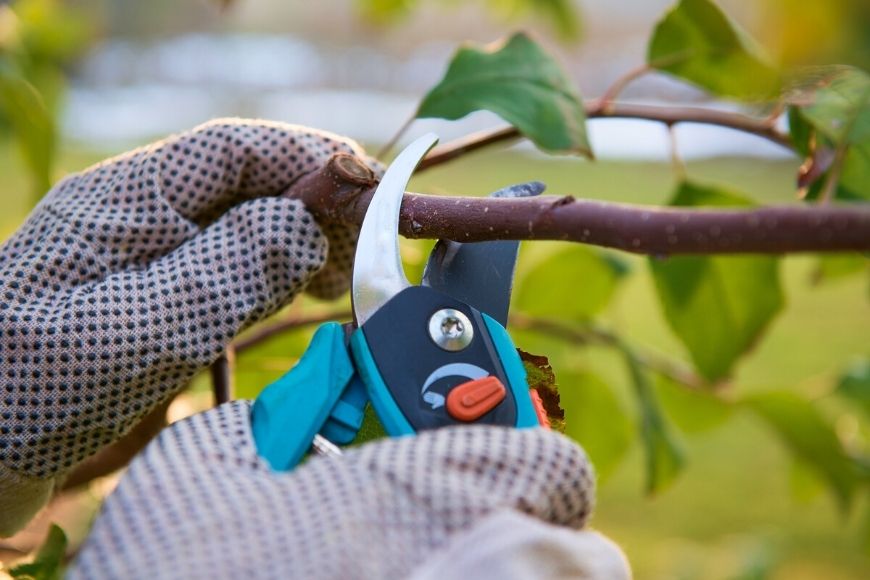
It’s easy to appreciate your yard being blanketed in snow during winter. The air is fresh and chilly, and you can take a break from high-maintenance tasks that some of your plants require, until spring.
It’s the perfect time to relax by a fire with warm cider or cocoa and enjoy your hardscaping and birds visiting your feeders. But before you completely clock out for the winter, keep in mind there are still a few outdoor shrubs and trees that can benefit from winter pruning.
To Prune, or Not to Prune?
You should prune most shrubs in winter. Pruning helps remove dead or unhealthy branches, and removing them during a dormant period will help the tree thrive when the weather warms.
Without their foliage, it’s easier to see the structure of trees and bushes to better identify branches that need to go. You can also better project what shape you want for your shrubs in the future.
Pruning is perfect for ensuring your plants stay healthy. It’s also a great way to get outdoors and bond with your plants until their foliage begins to grow back. For best results, you can use a sealer to trap in moisture on pruned cuts and protect your plants while they heal.
What To Prune in Winter?
- Fruit Trees
Pruning fruit trees in winter is an optimal time to do your best work because fruit and leaves will not be shrouding your view. Be careful not to prune in autumn. You want your fruit trees to reach dormancy before you engage in their care.
Types of fruit trees to trim:
- Apple trees
- Apricot trees
- Citrus trees
- Cherry trees
- Avocado trees
- Aprium trees
You can also mulch around your trees’ bases to ensure the roots don’t freeze.
- Fruiting Bushes & Vines
Fruit bushes and vines, such as grape and blackberry bushes, need to be pruned for the same reason as fruit trees. You can also insulate the roots with mulch, and trim and remove foliage to prevent rot.
Don’t prune them until December or January though. They need to be deeply dormant in order to prevent any “bleeds” from injuring the plants.
- Roses
Whenever you trim a rose bush, you’re going to need protection. Getting at least one pair of heavy gloves is the best way to ensure you don’t get pricked while pruning. It may seem innocuous to get a small cut on your finger, but it’s a surefire way to become at risk for rose gardener’s disease, a fungal infection.
Gloves, boots, and thick pants are the best way to cut out risks during outdoor work. Prepare to wake your roses come spring by reading this blog!
- Clematis
Clematis is a delicate and beautiful plant. To protect it during winter, make sure to snip off spent bloomed buds in February. Don’t forget to tie loose vines to their support structure, in case of strong winds.
You can also mulch the base of the plant to protect its roots. If your area is prone to heavy freezes, wrap your clematis in plastic or bubble wrap to further shelter it before the freeze arrives.
- Unruly Shrubbery
Mahonia and Viburnum are some of the shrubs that should be trimmed in late winter. They become unruly and can take over, so reducing their size in a dormant state is the best way to protect them and have manicured growth come springtime.
Mahonia can be trimmed until it’s standing 12 inches off the ground. Don’t worry, they’ll all bounce back beautifully next season!
Proper Pruning Techniques
Step 1: Wear gloves and ensure your shears are sharp. First and foremost, cut off dead, diseased, and damaged wood.
Step 2: Make a clean cut at an angle so that water doesn’t collect in the wound. Cuts should be just above the bud and you can use sealer once you’re finished too.
Step 3: Cut bushes so that they’re wider at the base. Light will be able to thoroughly touch it when it’s ready to grow. For fruit trees and fruit bushes, thin out the branches with your shears. The goal is to get as much light and ventilation in your plants as possible.
Step 4: Dip your shears in alcohol after each plant or tree to ensure you don’t spread diseases to your other plants.
Step 5: Tie back and or mulch the plants and trees that need extra protection. You can also wrap the base of your trees to protect against frost and rodents.
Taking the time to prune your plants in winter will mean gorgeous growth when winter melts away. Each season has its own perks.
So prepare your plants, kick up your feet, and enjoy the winter wonderland in a cozy sweater. Soon, your yard will be bursting with blooms and you’ll be back to tending to their new and improved growth.
Happy planting!
